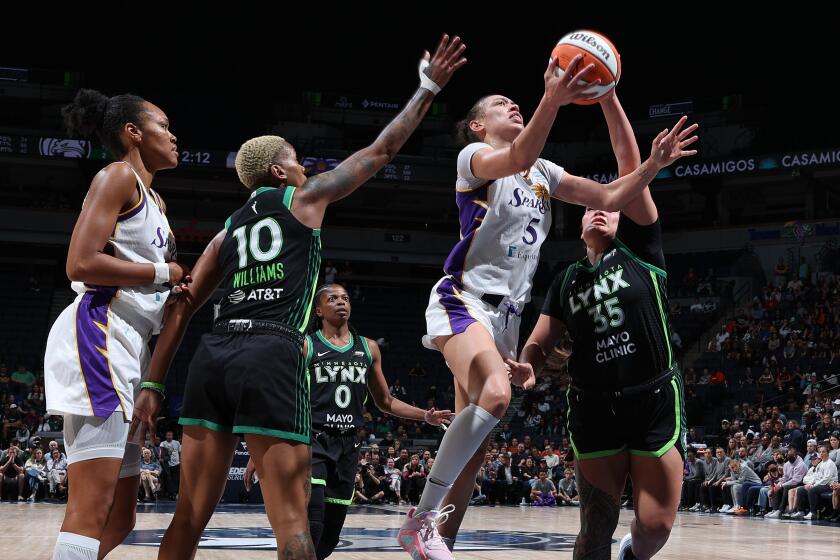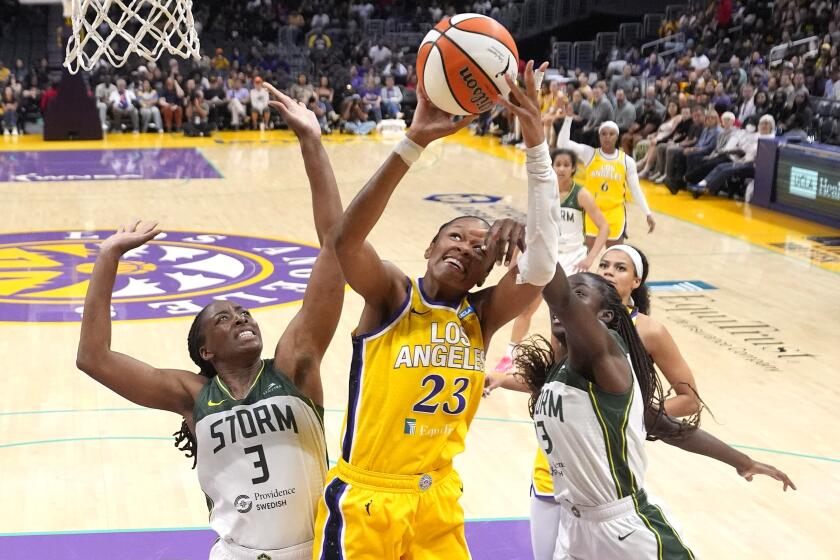Dales’ Return Hasn’t Been Easy
This is not what Stacey Dales envisioned when the former star guard for the Washington Mystics decided to end a one-year retirement and join the first-year Chicago Sky of the WNBA.
Seven games. Six losses.
Her contribution: an average of 4.1 points, 1.4 assists, 14 minutes. Even in her rookie season, 2002, she averaged 9.8 points, 2.6 assists and 26 minutes.
She expected the Sky, which faces the Sparks tonight, to struggle in its maiden season. But Dales, who is also a popular ESPN studio analyst and sideline reporter, did not expect her time off last season would hurt her this much.
She didn’t envision getting hurt either.
The 6-foot former All-Star suffered an injury to her right knee Wednesday night against the Seattle Storm. On Thursday, she was still waiting for MRI exam results.
“I expected a more expeditious return,” Dales said before the Sky practice on Thursday. “I had worked really hard in the off-season. And when you understand the game, you think you can play it at that speed again. But you can’t. You’re just a step, maybe just a fraction of a step, behind.”
That is not Dales’ only challenge, however.
Dales has Raynaud’s phenomenon, a disorder that causes blood vessels to constrict and can cause numbness and, occasionally, pain in the fingers, toes, ears or nose.
The disorder, which Dales has not previously talked about, usually strikes her fingers. Tough for a ballhandler.
Attacks can be brought on by exposure to cold, including heavily air-conditioned arenas, or by emotional stress. An episode can last less than a minute, or linger several hours.
The cause is unknown, and there is no cure. According to the National Institutes of Health, between 5% and 10% of the U.S. population has the disorder, and women are more likely to have it than men are.
All my life I have battled cold,” said Dales, 26, who was born in Ontario, Canada. “You can look at my hands now, and see the pigmentation is turning.
“It’s really nothing extraordinary, I’ll tell you that. It’s not life-threatening. [But] if I’m running up and down in air conditioning, I don’t sweat; I just get really cold and everything tightens up. If I pick weights up, sometimes I have to peel my fingers back to let it go.”
Dales said she first felt something was wrong while at Oklahoma, where she was a two-time All-American and helped the Sooners reach the 2002 NCAA Division I championship game before losing to Connecticut.
She came into the WNBA as the third overall pick by the Mystics in the 2002 draft. But as the numbness in her hands continued, Dales sought medical help. Finally, her condition was diagnosed.
To combat the disorder, Dales said she takes a cayenne pepper supplement, has a glass of red wine a day (said to help blood vessels), and an occasional aspirin.
“And I have to get really warm during the pregame preparation. There’s not much else I can do,” she said.
Still, Dales doesn’t want Raynaud’s phenomenon to derail her second chance at pro basketball. Even though she has established herself in broadcasting, Dales realized how much she missed playing the game.
Sky Coach Dave Cowens, who took two seasons off during his 11-year NBA career, empathizes with Dales’ frustration.
“Her game is coming, but there’s a long way to go,” he said. “She needs to get some strength back.”
Dales agrees.
“I don’t take any of this for granted,” she said. “This summer will be a great test. I’m following my heart, which I do more of now.... I don’t have any predetermined idea of what is going to happen.”
*
Begin text of infobox
The facts
Raynaud’s phenomenon is a disorder that causes the blood vessels in the ears, fingers, nose and toes to narrow:
Common symptoms:
* Discoloration of the area, such as blue or white fingertips.
* A feeling of unusual cold or numbness in the affected areas.
* As attack ends, throbbing and tingling can occur.
Common triggers:
* Exposure to cold, including air conditioning; stress.
Some forms of treatment:
* Stay warm.
* Control or avoid stressful situations.
* Avoid handling frozen foods or other very cold objects.
* Exercise regularly.
*
Source: National Institutes of Health
More to Read
Go beyond the scoreboard
Get the latest on L.A.'s teams in the daily Sports Report newsletter.
You may occasionally receive promotional content from the Los Angeles Times.










